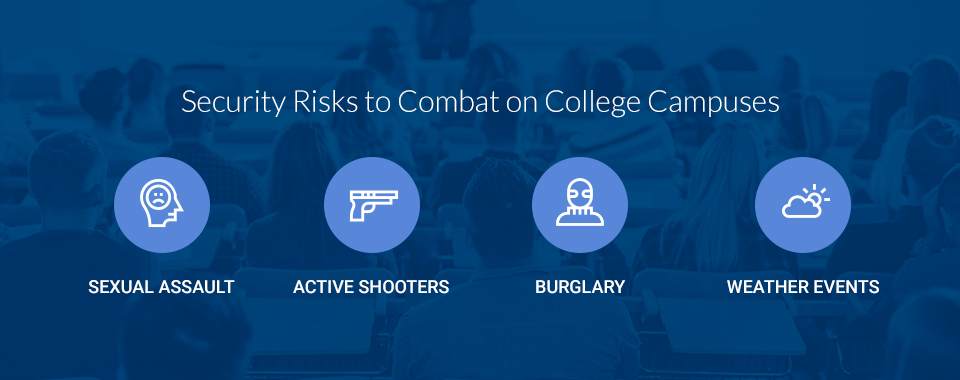For most of our history, Americans have felt relatively safe and isolated from violence, as they’ve gone about their daily lives. Of course, there were inner city areas where higher crime rates produced headlines in daily newspapers, and isolated events throughout the country that focused national attention on horrific violence. But, most Americans took the position that “it can’t happen here, or to me.” Then came the 1999 shooting spree at Columbine High School in Colorado. And, in a matter of hours, our illusions about personal safety and security were shattered. If the unthinkable could occur on a high school campus in heartland America, it could happen anywhere, anytime, to anyone. When the terrible events of September 11, 2001 confirmed America’s vulnerability to terror and violence, the entire country began an immediate transformation to a much higher state of security and Mass Notification System awareness.
Nowhere has the concern for personal protection hit home more than on the campuses of our colleges and universities. As security breaches became almost commonplace in virtually every area of the country, officials of public educational institutions, especially those located in inner cities, were quick to add security measures ranging from metal detectors in lobbies, to in-school security forces, to police-manned perimeters.
The very essence of a college or university campus, however, is openness. Naturally, there is a resistance to encircling entire campuses with barbed-wire fences, adding armed guards, or forcing people to enter buildings through metal detectors.
In the security design profession, we understand that we cannot always prevent incidents from occurring. But, it is essential that we possess the capability to respond quickly to mitigate and limit the damage. It is easy to understand why instead, the focus and emphasis is being placed on responding to the mass notification challenge: how to best communicate with all campus occupants in the event of an emergency situation.
The Purpose of the Mass Notification System on Campuses
What situations could occur that would require campus officials to be able to communicate with all the people on campus? According to a Motorola Public Safety Survey of public safety officials, the top concern was a natural disaster. Judging from recent hurricanes in the South, as well as fires in the West, this concern is well-founded.
In addition to weather-related emergencies, potential threats include security breaches, acts of terrorism, chemical releases, fires, utility outages or any other type of disruptive event. The purpose of a campus-wide mass notification system is to provide a reliable method for officials to notify people on campus of an emergency event and explain what is happening, what to do, where to go and when it’s safe to resume normal activities.
The mass notification system must have the capability to send instructions to people in specific spaces, floors, buildings and facilities throughout the campus, or in some instances, to an entire regional or global network of people. These instructions can be transmitted via loudspeakers, voice-equipped fire alarms systems, public radio/ television networks, computers, telephones and cell phones, visual displays and signage, and two-way radios.
Advances in Mass Communication Notification System Technology
The leading-edge technology of mass notification has always resided in the government sector where the risk of security breaches are the highest and the consequences are can be the most devastating. Following 9/11, it became apparent that in order to protect ordinary citizens from terrorism and violence, the government’s advanced technology must be shared with system developers, manufacturers and integrators in the private sector.
Under the guidance of the Department of Homeland Security (DHS), the government is still pioneering of new technology. But, because the government is now sharing its lessons learned and technology applications, the private sector is now in a better position to apply this technology to their mass notification challenges.
The flood of new security technology into the marketplace has raised the capabilities of mass notification exponentially. New products and systems are hitting the market every day. They are smarter, faster, smaller and less expensive than ever before.
Complementing this proliferation of mass notification technology is a consumer base with real-world needs. The college or university president wants immediate security solutions to publicize to the parents in the processing of selecting a safe learning environment for their child. The college or university also has a responsibility to protect the people who work on campus, whether it’s a single building, multiple buildings or facilities spread across the country.
What is the right campus mass notification system?
At many of the mass notification seminars we’ve conducted in the past several years, one question always comes up: “If I have a limited budget for a mass notification system, what’s the one system I should spend it on?” Our answer is always the same: “Rather than investing in hardware, first find a good consultant capable of guiding you through the entire mass notification process and show you how to leverage the technology that you already own.” In many cases, the top campus official is still intrigued with finding the “magic” system that will guarantee a horrific event will not occur on his or her campus.
The most popular approach to this type of “instant notification solution gratification” on campuses today is the digital text messaging system. The well-founded theory behind it is that all students carry mobile phones. So, in the event of an emergency, campus officials simply send mass notification instructions as text messages to the students’ cell phones. While this sounds like the perfect solution, in theory, and we would certainly advocate its use, in actual practice there are a few flaws. For example, a major natural disaster might knock the digital system or the electrical power necessary to run it offline. In addition, the college or university may only be successful in signing up 20-30% of the students for the text messaging service. What about the other 70-80% of the students? Or, what if the message recipients are in locations where their cell phones must be turned off… in a lecture hall for example?
The truth is an effective mass notification system is not a single system, it’s a process that involves leveraging many, if not all, of the monitoring, communications and control systems in your building or on your campus.
The Process of Mass Notification on Campuses
Achieving an effective, efficient mass notification system on a campus requires comprehensive preparation and precise execution. We’ve broken the process down into five key steps:
Step 1 – Assess the threats to your campus.
Every campus situation is different. A rural campus in Kansas might be more vulnerable to violent tornadoes than a campus located in downtown Chicago where the major threat could be drug-related security breaches from surrounding neighborhoods. Both campuses may need to take precautions against disturbed or disgruntled students or staff members.
Campus officials won’t be in a position to design intelligent mass communications response until they analyze the vulnerabilities and threats unique to their campuses, and to the faculties, students and visitors (or employees, in the case of corporate campuses). This analysis must take into consideration what events could possibly happen and how they rank in probability of occurrence from most likely to least likely.
According to a Motorola Public Safety Survey, these are the major identified threats and the percentage of public safety officials who ranked each one the top threat:
- Natural disasters – 65%
- Drug trafficking or drug possession – 11%
- Non-drug related crimes – 10%
- Terrorist attacks – 7%
- Fires – 2%
In addition to identifying what threats are most likely to strike the campus, you need to assess when (time of day, time of year, special dates) and where (specific office, building or facility) the event could take place. Creating worst-case scenarios for each threat is a good way to begin getting a handle on the mass notification challenge your campus is facing. Since no one has a crystal ball, this exercise is highly subjective, yet very necessary in the mass notification process.
Step 2: Investigate your infrastructure.
Most campus officials assume the need to start from scratch when it comes to the system hardware and software necessary for mass notification. But, many of the systemic pieces are already in place. What is generally missing is an overview of how the campus operates on a daily basis, if these critical systems are interoperable and how they can be integrated and re-tasked during an emergency to serve a single command and control function, that of mass notification.
In most cases, you’ll find four different types of systems on a modern campus. They include life safety (fire, gas and smoke detection, alarm and sprinkler systems); security (surveillance, access control and intrusion monitoring systems); building automation (HVAC) and communications (voice and data systems). Typically, each of the four system categories falls under a separate jurisdiction.
For example, the campus police are responsible for providing a secure environment so the security command center is their turf and they oversee the selection and purchase of any type of security system hardware or software. They may also be responsible for the life safety function, or there could be a separate campus fire protection department in charge. Building automation is most often the domain of a facilities management group while information technology/information management falls under yet another autonomous group.
Each of the groups we mentioned tends to function as a separate “silo.” Each has a separate chain of command, their own unique objectives, procedures and dedicated budgets. Ensuring that their systems are compatible with another group’s systems is not high on anyone’s priority list. They also tend to compete for dollars and human resources.
This is not an ideal situation when the objective is to build a seamlessly effective, campus-wide mass notification system. That’s why this important investigation step must be taken unilaterally. You’ll need to know going in which systems can be used as part of your mass notification infrastructure, which must be upgraded or removed and what new technology you must add in order to have a fully integrated, enterprise-wide mass notification process.
In addition, you’ll want to factor in the creation of a central command center dedicated to integrating all the incoming information and outgoing messages. The security command center, if it exists in proper form, can serve as the central command center for emergency event management. The key to effective management of any emergency situation is having situational awareness of the event. In other words, you need to have visual and informational knowledge of what’s taking place in real-time terms. This is critical in a mass notification process where decisions involving moving people must be made in minutes or seconds, not hours.
Step 3: Design and implement your mass notification system.
Once you’ve completed the investigation step, you now know what improvements or additions must be made to your infrastructure and where these enhancements are most critically required in order to achieve total system integration and interoperability. Since very few campuses can afford to do everything at one time, you’ll want to create a phased implementation plan, complete with budget estimates and detailed specifications for every system.
The implementation plan will enable you to compare and obtain competitive bids from leading hardware and software suppliers. Once the bids have been awarded and the construction begun, you’ll no doubt require the services of a security consultant able to provide on-site project and construction management. The consultant should also be qualified to oversee the testing and commissioning of the life safety, security, communications and IT systems, as well as, to assist in obtaining the necessary code approvals.
The implementation phase also includes training on the systems. This not only involves the people who operate and maintain the systems, but also the people who populate the campus and must respond se properly in order to be safe. The system training should be a part of your overall emergency response training program.
Step 4: Create an emergency response plan.
The emergency response plan is the single most important part of the mass notification process. You’ve identified the threats to your campus; created worst-case scenarios; evaluated your systems; and identified the hardware and software issues you need to address. Now it’s time to create a blueprint for how the mass notification process will function in an actual emergency.
The emergency response (ER) plan identifies your mass notification response team and assigns responsibilities. It determines what messages will be sent in specific situations; where you will instruct people to go; by what routes; to which safe areas. It details evacuation plans and provides for signage to guide your campus occupants to safety.
The ER plan further explains how your ER team will be trained and lays out methods for implementing training activities with different simulated emergency scenarios. It also focuses on the cooperation and synergy required from local government, fire, police, medical and disaster recovery personnel and provides a methodology for accomplishing a total response to any type of crisis.
Step 5: Test your operational readiness.
Over time, things change and so must your mass notification process. A campus is a growing, evolving community, from a structural, operational and human standpoint. Therefore, it is necessary to conduct regular periodic tests and evaluations of not only your mass notification process, but also your sub-systems, procedures and emergency response actions.
Keeping America’s campuses secure and their occupants’ safe is a monumental task, not without setbacks. No matter how prepared a campus is, incidents can and will happen that take lives and cause injuries. But, the frequency and severity of these events can and will be mitigated through proper application of a proven mass notification system and technology.
College Campus Security Regulations
The regulations governing campus security in the United States are extensive and specific. College campus security management needs to be familiar with the litany of definitions and requirements, especially the Clery Act.
The Clery Act
The Clery Act is the most important regulation to follow regarding college campus safety. The Act was designed to create transparency about statistics and policy for campus crime. It requires that colleges provide detail-heavy breakdowns of crimes that happen on campus. It also demands that colleges provide students with a means of notifying the college that campus emergency events are occurring and conduct emergency response testing. Campuses must also have policies and procedures in place for crime and fire safety.
The Act has undergone several changes and expansions, including the most recent update in 2013. These multiple updates have made it more and more difficult for learning institutions to remain in compliance, especially those that do not have the adequate resources necessary for maintaining compliance-specific teams. The Department of Education (DOE) is stringent about enforcing the Act, and several institutions have received punishment for failing to implement proper college campus emergency management. In addition to steep fines, non-compliance can lead to serious damage to a college’s reputation.
The Handbook for Campus Safety and Security Reporting
The Clery Act is extremely complex, so the federal government has provided multiple updates to a document called The Handbook for Campus Safety and Security Reporting. This document contains helpful information, such as:
- How to determine if your institution must comply with the Higher Education Act of 1965 (HEA).
- How to identify campus, non-campus and public property.
- How to classify and count Clery Act crimes.
- How to create and effectively use the daily crime log.
The Handbook can provide a good jumping-off point for beginning a campus emergency framework, although it is not a comprehensive guide.
Security Risks to Combat on College Campuses
Students today face a variety of challenges, both academically and socially. There are also several overarching security issues that they must contend with, including:
1. Sexual Assault
Sexual assault on college campuses has garnered significant negative publicity in the past few years, as institutions struggle to prevent and cope with the phenomenon. According to a 2019 study, there is a 13% rate of non-consensual sexual contact on campuses, and, in many cases, there are prior warning signs — such as stalking or harassment — that an assault could take place.
The Clery Act requires that incidents of stalking and harassment are recorded. Once college campus security has logged these acts, mass notification systems can alert the student body of criminal behavior that may be a precursor to sexual assault.
2. Active Shooters
The dreaded situation in which an active shooter has opened fire on campus is a campus emergency event that demands thorough planning. In many cases, an active shooter uses high-capacity firearms and has no set pattern for selecting their victims, meaning that the event will evolve rapidly and unpredictably.
When an active shooter is moving from location to location, mass notification systems have the potential to save lives. Implementing a network that allows students, staff or administration to quickly alert the entire campus can give students time to get to safety and begin emergency procedures as indicated by the institution’s policies.
3. Burglary
The most recent data from the National Center for Education Statistics indicates that, in 2016, more than 6,700 burglaries occurred in campus residence halls, and almost 5,300 burglaries occurred in other areas of college campuses.
To combat the high rate of burglary, many institutions are trying to educate incoming students on how best to protect their space and property. However, preparation alone isn’t enough. Mass notification systems can prevent serial burglaries by putting the student body on alert. This solution can help students defend against would-be burglars and help with the process of identification, as students are made aware of any identifying details reported by the initial victim.
4. Weather Events
While many campus emergency events are not predictable, weather events are some of the most common emergencies for which an institution can plan. Universities and colleges can coordinate with community safety officials to ensure mass notification systems are tied into local weather alerts as part of an emergency preparedness plan.
Being prepared for multiple types of inclement weather and having policies in place for evacuation and other emergency procedures is essential to reacting swiftly and potentially saving lives or preventing injury.
Importance of Emergency Response Planning and Management
Ensuring safety and security is a collaborative effort that requires intentional coordination and planning. Working together to create a comprehensive college campus emergency management plan is the best way to prevent costly and often tragic incidents and show that the institution’s administration understands the importance of safety and security.
Mass notification systems help build transparent lines of communication between campus administration and students as well as their families, helping to strengthen ties between the institution and the community by creating a safer campus.
Emergency response planning and management should take college campus life safety into account first, but it is also essential to business continuity. Institutions must do their best to protect students, but they must do so in the context of being a functional business. When disaster strikes, the continuity plans must follow swiftly behind actions taken to reduce the risk of death and injury.
A business continuity plan lays out the specific roles and responsibilities of each department and staff member for the duration of an emergency. It should address the most effective use of resources in multiple contingencies, so the institution can continue to operate in the event of one or more emergency situations. All colleges and universities, regardless of size and number of students, can benefit from emergency management and operations continuity consulting to develop a plan without overextending existing teams.
Trust Telgian for Campus Security Consulting and Life Safety
If your institution needs mass notification systems to respond to campus emergency events, Telgian is ready to help. Our extensive experience in the industry covers fire, security and life safety in a variety of settings. Our fire protection engineers, system designers and security consultants have unique perspectives on the challenges of college campus emergency planning and are ready to share their expertise.
Telgian is proud to provide customized solutions that match your institution’s needs and priorities when it comes to safety. Contact us to learn more about our campus security consulting and emergency planning solutions today.
William Sako is the Vice President and Corporate Practice Leader of Security Risk Consulting for Telgian Engineering & Consulting, LLC. Telgian is a worldwide provider of comprehensive security, fire, life safety and emergency management consulting and engineering services. Mr. Sako is one of the most experienced security consultants in the United States. His work, which spans over five decades for government, private companies and educational facilities, demonstrates a common-sense approach to security without the emotion that arises when dramatic events occur.
Mass Notification System / Media and Interview Inquiries:
Susan McNeill
Telgian Holdings, Inc.
smcneill@telgian.com
480-621-5031
This post was last updated on June 30, 2020.





